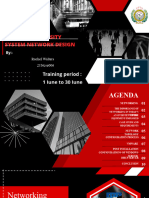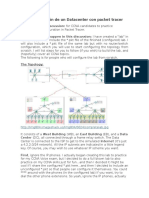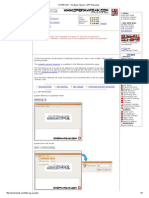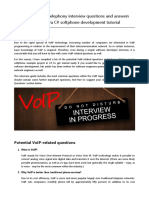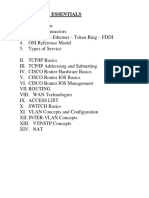National Textile University, Faisalabad
Department of Computer Science
Name: Fareena Shahbaz 23-NTU-CS-1024
Class: BSCS 4th _A
Course Code: COC-2078L
Course Name: Information Security
Submitted To: Mam Kainat Abdullah
Submission Date: 16/06/2025
1
�PROJECT TITLE
Enterprise Network Design:
Interconnecting Branch Offices Using
VLANs and Static Routing
2
�Contents
Introduction...............................................................................................................................................3
Problem Statement....................................................................................................................................4
Network Description.................................................................................................................................4
IP Addressing And Subnetting..................................................................................................................4
Server IP Assignments:..........................................................................................................................5
Network Topology......................................................................................................................................5
1. Headquarters Network.................................................................................................................5
2. Site 1..............................................................................................................................................6
3. Site 2..............................................................................................................................................6
VLAN Configuration.................................................................................................................................7
Testing and Verification............................................................................................................................7
Routing Design...........................................................................................................................................7
Inter-Site Connectivity..............................................................................................................................8
Configuration Details and Routing Tables...............................................................................................8
Additional Features...................................................................................................................................8
Testing and Verification............................................................................................................................9
Summary and Conclusion.........................................................................................................................9
Future Enhancements...............................................................................................................................9
Introduction
This report outlines the simulation and configuration of a multi-site enterprise network using
Cisco Packet Tracer. The simulated network includes a Headquarters and two branch sites (Site 2
and Site 3), interconnected through routers and switches. The goal was to implement effective IP
addressing, configure VLANs, and ensure static routing for seamless inter-site communication
and access to centralized services like DNS, HTTP, and DHCP.
3
�Problem Statement
In modern organizations, especially those with multiple branches or remote offices,
maintaining efficient, secure, and reliable communication between departments is critical.
Many small-to-medium enterprises face challenges like:
Lack of network segmentation, leading to inefficient traffic flow and poor security
Network Description
The network is designed with three main locations:
Headquarters – the central node, hosting a DHCP server and multiple switches and PCs.
Site 2 – connected to both the Headquarters and Site 3. Hosts a DNS server (bing.com)
and an HTTP server (google.com).
Site 3 – the final site in the network chain, with its own DHCP server and multiple end
devices.
Each site is connected via routers and communicates through statically configured routes.
Ethernet links are used for LAN connections and WAN links (represented in red lines) are used
for router-to-router communication
IP Addressing And Subnetting
Each router interface and end device is assigned an IP address based on a logical addressing
plan:
4
�Router IP Assignments:
Device Interface IP Address
Router0 To HQ LAN 192.168.4.1
Router0 To Router1 192.168.1.1
Router1 To Router0 192.168.1.2
Router1 To Router2 192.168.2.1
Router1 To Site 2 LAN 192.168.5.1
Router2 To Router1 192.168.2.2
Router2 To Site 3 LAN 192.168.3.1
Server IP Assignments:
Headquarters DHCP Server: 192.168.4.2
Site 2 DNS Server (bing.com): 192.168.5.2
Site 2 HTTP Server (google.com): 192.168.5.3
Site 3 DHCP Server: 192.168.3.2
Subnetting is done using /24 for all subnets for simplicity and clarity.
Network Topology
1. Headquarters Network
Switches:
o Two multilayer switches (3650-24PS)
5
� o Four layer-2 switches (2960 series)
o PCs:
o PC0 to PC15 are connected to different switches
o Connected via VLANs (likely for segmentation)
5. Server:
o DHCP-2 at IP: 192.168.4.2
6. Router Connection:
o Router0 connects to both the internal network and to Router1 (inter-site link)
2. Site 1
Router1 connects:
o To HQ via 192.168.1.1
o To Site 3 via 192.168.2.1
Switch:
o 3650-24PS Multilayer Switch2
Servers:
o bing.com - DNS: 192.168.5.2
o google.com - HTTP: 192.168.5.3
3. Site 2
Router2 connects:
To Site 2 via 192.168.2.2
To LAN: 192.168.3.1
Switches:
One 3650-24PS multilayer switch
Two 2950T-24 switches (Switch4, Switch5)
6
�PCs:
PC17 to PC20 are connected here
Server:
DHCP-1 at IP: 192.168.3.2
VLAN Configuration
At the Headquarters, VLANs are used to segment traffic across different departments. PCs are
distributed across these VLANs using the 3650 and 2960 switches. Trunk links are configured
between switches to carry VLAN traffic. Each VLAN is assigned a unique subnet:
VLAN 10: 192.168.4.0/24 (e.g., for Admin)
VLAN 20: For another department, and so on...
The Layer-3 switch handles inter-VLAN routing locally at the HQ.
Testing and Verification
Ping Test:
Ping from Site 3 (PC17) to HQ (PC16) – success shows routing is working.
VLAN Test:
Ping between different VLAN PCs in HQ – confirms inter-VLAN routing.
DHCP Test:
PCs in HQ and Site 3 get IPs automatically – DHCP is working.
DNS Test:
ping bing.com – name resolves, DNS is working.
HTTP Test:
http://google.com in browser – page opens, HTTP server works.
Routing Design
Static routing was implemented across all routers for simplicity and control. Each router was
manually configured with routes to reach all subnets within the network. Since this is a small
network, static routing is effective and easy to troubleshoot.
Example static route on Router0:
ip route 192.168.3.0 255.255.255.0 192.168.1.2
This allows Router0 to reach Site 3’s network via Router1
7
�Inter-Site Connectivity
Inter-site connectivity is achieved via point-to-point links:
Router0 ↔ Router1: 192.168.1.0/24
Router1 ↔ Router2: 192.168.2.0/24
Each router is aware of remote networks through static routes. These connections simulate a
WAN using Ethernet or serial links (red lines). The routing tables ensure connectivity between
Headquarters, Site 2, and Site 3
Configuration Details and Routing Tables
Each router includes the following:
Configured interfaces with IP addresses
Static route entries for all other subnets
Proper no shutdown on all interfaces
Example routing table from Router1:
192.168.1.0/24 is directly connected (to Router0)
192.168.2.0/24 is directly connected (to Router2)
192.168.4.0/24 via 192.168.1.1
192.168.3.0/24 via 192.168.2.2
Additional Features
DHCP Configuration:
o Site 3 and Headquarters use DHCP servers to dynamically assign IPs to PCs.
DNS and HTTP Simulation:
o Site 2 hosts bing.com and google.com to simulate name resolution and HTTP responses.
Multilayer Switching:
o Used at each site for routing within VLANs and efficient Layer 3 traffic handling.
8
�Testing and Verification
The network was tested using PDUs (ping tests) across different sites. One of the tests involved:
Sending an ICMP packet from PC17 (Site 3) to PC16 (Headquarters).
The ping was successful, indicating end-to-end connectivity and proper routing.
Other tests included verifying:
DNS resolution from clients to bing.com
HTTP response from google.com
DHCP IP assignment from DHCP servers to clients
Summary and Conclusion
This project successfully demonstrates the design and implementation of a multi-site enterprise network
using static routing, VLAN segmentation, and essential services like DHCP, DNS, and HTTP. The setup
ensures efficient communication between all departments and remote branches. The use of static routing
and manual configuration helps students understand the foundational concepts of routing, addressing, and
service simulation in a networked environment.
This simulation provides a strong base for future extensions like dynamic routing protocols (e.g., RIP,
OSPF) or security features such as Access Control Lists (ACLs)
Future Enhancements
While the current network design achieves basic inter-site connectivity and service deployment,
there is scope for several future improvements:
Dynamic Routing Protocols: Implementing OSPF or EIGRP would allow automatic route
updates and better scalability as the network grows.
Redundancy & High Availability: Adding a backup route or redundant router paths using
HSRP or VRRP would improve network reliability.
Network Address Translation (NAT): Configuring NAT could allow internal hosts to
access external networks while preserving IP address space.
Wireless Integration: Expanding the network to include wireless access points (APs)
would support mobile devices and improve flexibility.
IPv6 Transition: For future-proofing, dual-stack or full IPv6 support could be gradually
implemented

